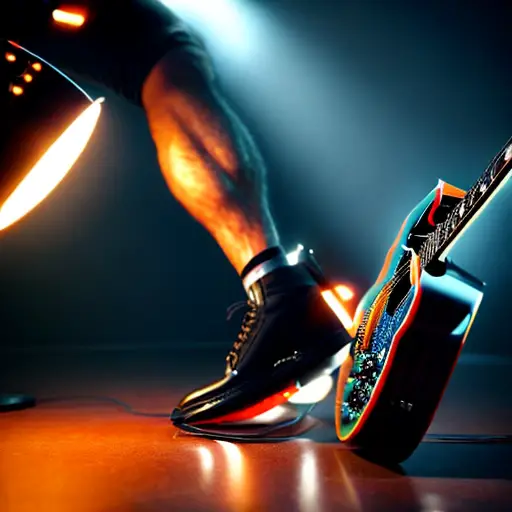Getting Started: Navigating the Fretboard
Alright, fellow aspiring guitar gods, let's tackle the daunting task of navigating the fretboard like a pro and unleashing your inner rockstar! Now, I know what you're thinking – the fretboard can be scarier than a spider with eight million legs, but fear not! We'll break it down step by step, starting with the basics. First, familiarize yourself with the strings. They're like the trusty highway guiding you to musical nirvana. Then, get cozy with those frets – they're the road signs that determine the pitch of each note. Once you've mastered the art of placement, it's time to embark on the epic quest of soloing. Your fingers will dance across the fretboard like nimble ninjas on a mission to melt faces and hypnotize the crowd. So, buckle up your guitar strap, my friends, and get ready to rock 'n' roll your way to soloing stardom!
Essential Techniques for Guitar Soloing
An interesting fact about learning to solo on guitar for beginners is that the pentatonic scale, a five-note scale widely used in rock, blues, and pop music, is often the first scale taught to new guitar players. Due to its simplicity and versatility, this scale empowers beginners to create impressive and captivating solos without having to master complex musical theory or fingering techniques. It serves as a gateway to developing creativity, improvisation skills, and musical expression on the guitar.
So, you've finally decided to embark on the epic journey of shredding on a guitar? Oh boy, get ready to unleash those inner rock god vibes! Now, when it comes to guitar soloing for beginners, there are a few essential techniques that can take you from strumming campfire tunes to melting faces in no time. Let's start with the good ol' pentatonic scale – it's like the superhero of scales, always ready to save the day with its five magical notes. Then there's bending – it's not just for yoga, my friend. Bending those strings will give your solos that sweet, soulful touch that makes the audience swoon (and saves you from doing your laundry). And finally, let's talk about vibrato – it's the secret ingredient that adds flavor to your solos, like that dash of hot sauce on your grandma's famous meatloaf. So, buckle up, dear beginners, because once you master these techniques, the world will have no choice but to bow down to your guitar-wielding magnificence!
Building Your Soloing Vocabulary with Scales and Patterns

So, you've decided to set out on the wild journey of learning how to solo on guitar, huh? Well, my dear friend, you've come to the right place because I am your trusty blogger with a sense of humor, ready to enlighten you on the art of building your soloing vocabulary with scales and patterns. Now, before we dive into this magical world of fretboard explorations, let me just say, don't fret (pun intended) if you're a beginner because everyone starts somewhere, and even the greatest guitar gods were once mere beginners, strumming awkwardly and making funny faces in front of the mirror.
Alright, let's get down to business! The first thing you need to know is that scales are your secret weapon, your golden ticket to unlocking the vast universe of guitar solos. It's like having a superpower, only instead of shooting laser beams out of your eyes, you'll be shredding mind-blowing riffs that will make heads turn and jaws drop. So, grab your guitar and brace yourself because we're about to embark on this epic journey together.
Now, imagine scales as your colorful palette of musical notes, waiting for you to pick up your paintbrush and create a masterpiece on that fretboard canvas. Start with the good old friend, the major scale. It's like the Beyoncé of scales – a versatile, queen-like scale that forms the foundation for countless iconic solos. Practice playing it up and down the neck until you can do it with your eyes closed. Okay, don't actually close your eyes because, trust me, navigating the fretboard blindly is a recipe for disaster.
Now that you've mastered the major scale, let's spice things up a bit with some patterns. Patterns are like the spices that add that extra flavor to your solos, making them tantalizing and unforgettable. One popular pattern is the pentatonic scale, which sounds like some mystical voodoo spell, but fear not, it's just a funky five-note scale that effortlessly adds a touch of bluesy goodness to your solos. Its simplicity is what makes it beautifully addictive, so practice it in different positions on the neck until it feels as natural as breathing.
But wait, there's more! Introducing the world of arpeggios, the icing on the cake of soloing brilliance. Arpeggios are like magic formulas that, once unleashed, can transport your solos to a whole new level. Mastering arpeggios means being able to turn any chord into a breathtaking cascade of notes, spiraling up and down the fretboard with precision and finesse. Start with the basic major and minor arpeggios, and gradually expand your arsenal to include dominant, diminished, and even the mysterious-sounding augmented arpeggios.
Now, my ambitious beginner, don't get overwhelmed. Building your soloing vocabulary takes time, persistence, and hours of practice. It's like learning a new language, except instead of ordering food and asking for directions, you're communicating your deepest emotions through the language of music. So, be patient with yourself and embrace the journey, because every mistake, every missed note, and every awkward bend will eventually shape you into the rockstar you're destined to become.
Remember, music is not just about technicality; it's about expression, passion, and having fun. So, along your soloing quest, don't forget to let loose, experiment, and add your own twist to the mix. After all, the world doesn't need another carbon copy of Jimi Hendrix or Slash – it needs YOU, with your unique personality and humor, rocking that guitar like nobody else. So, my dear beginner, go forth and conquer the fretboard, one scale, one pattern, and one ridiculously awesome solo at a time. Your destiny awaits!
Putting It All Together: Tips for Improvising and Creating Memorable Solos
Fun fact: Did you know that one of the most common ways to start soloing on guitar as a beginner is by using the minor pentatonic scale? This scale consists of only five different notes and is widely used in various genres of music, making it a great starting point for beginners to explore and create their own solos!
So, you've decided to embark on the journey of becoming a guitar solo master, huh? Well, my friend, you've come to the right place! In this wild world of music, being able to improvise and create memorable solos is like having a secret weapon up your sleeve. And hey, who doesn't want a secret weapon, right? So grab your trusty six-string and get ready to dive into the glorious realm of guitar solos. Just remember, even though you're a beginner, you can still unleash your inner rock god (or goddess) with a little bit of practice and a whole lot of pizzazz. Trust me, it's all about putting it all together, sprinkling a dash of magic, and watching those fingers fly across the fretboard like a caffeinated squirrel on a mission!



